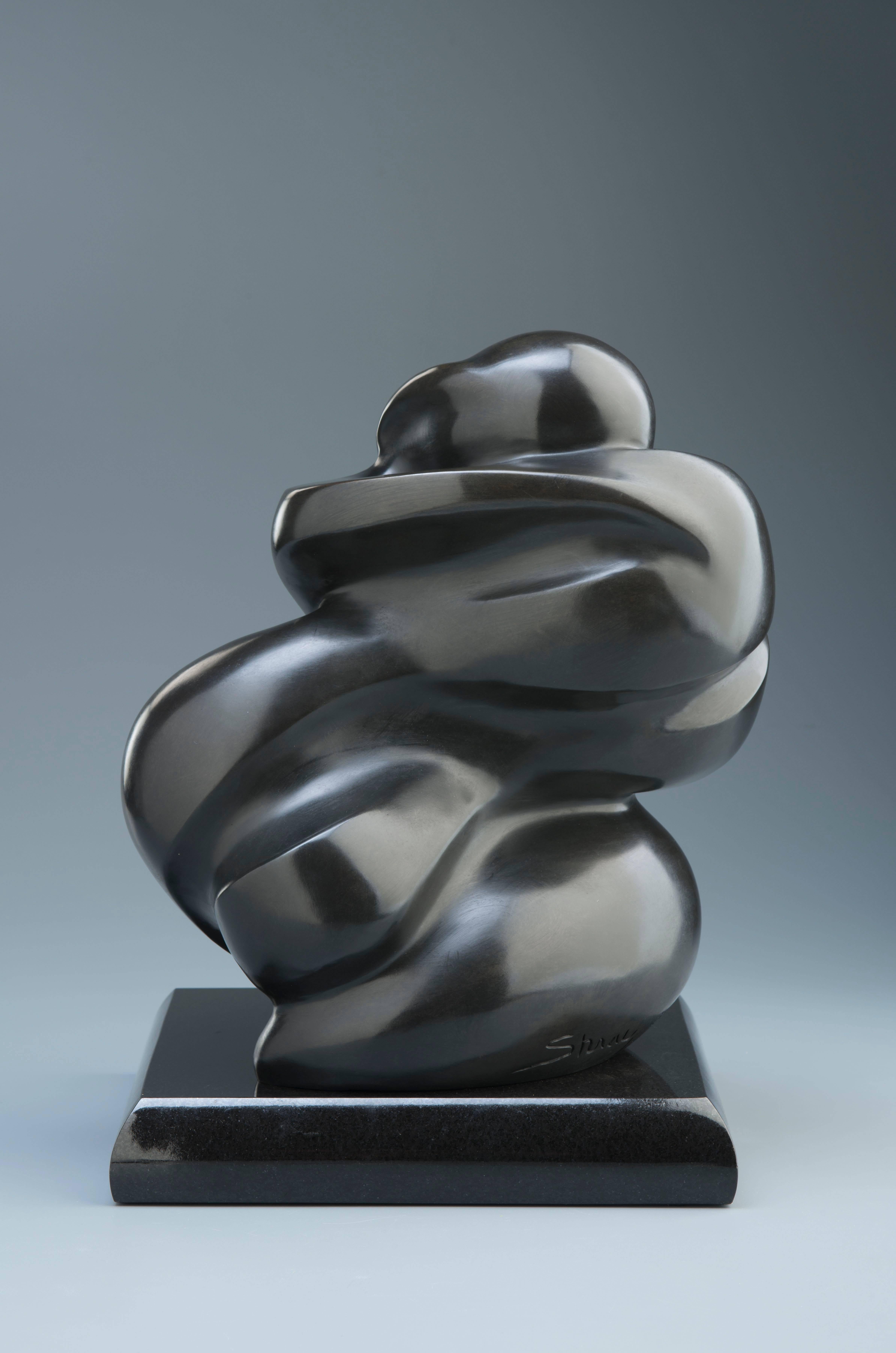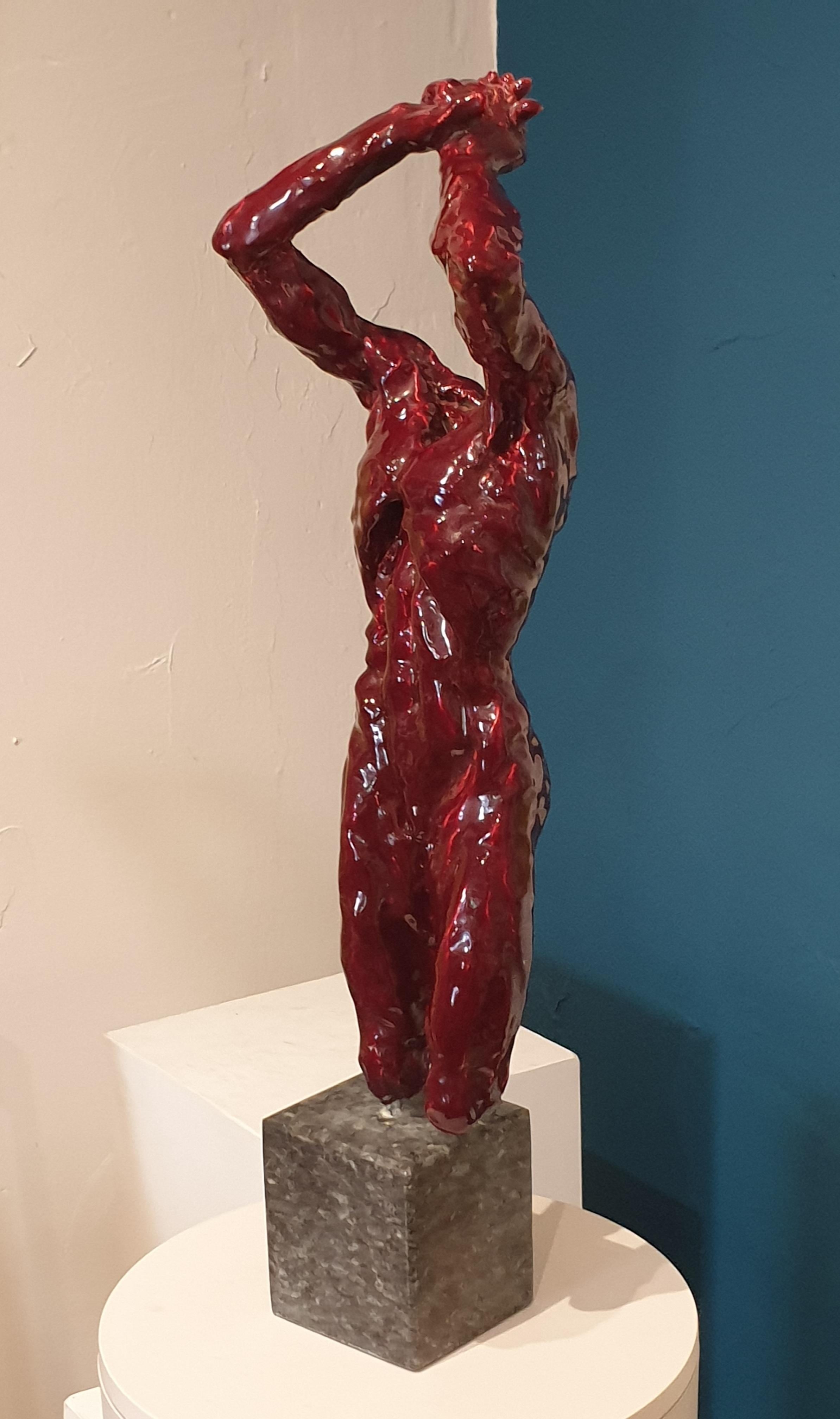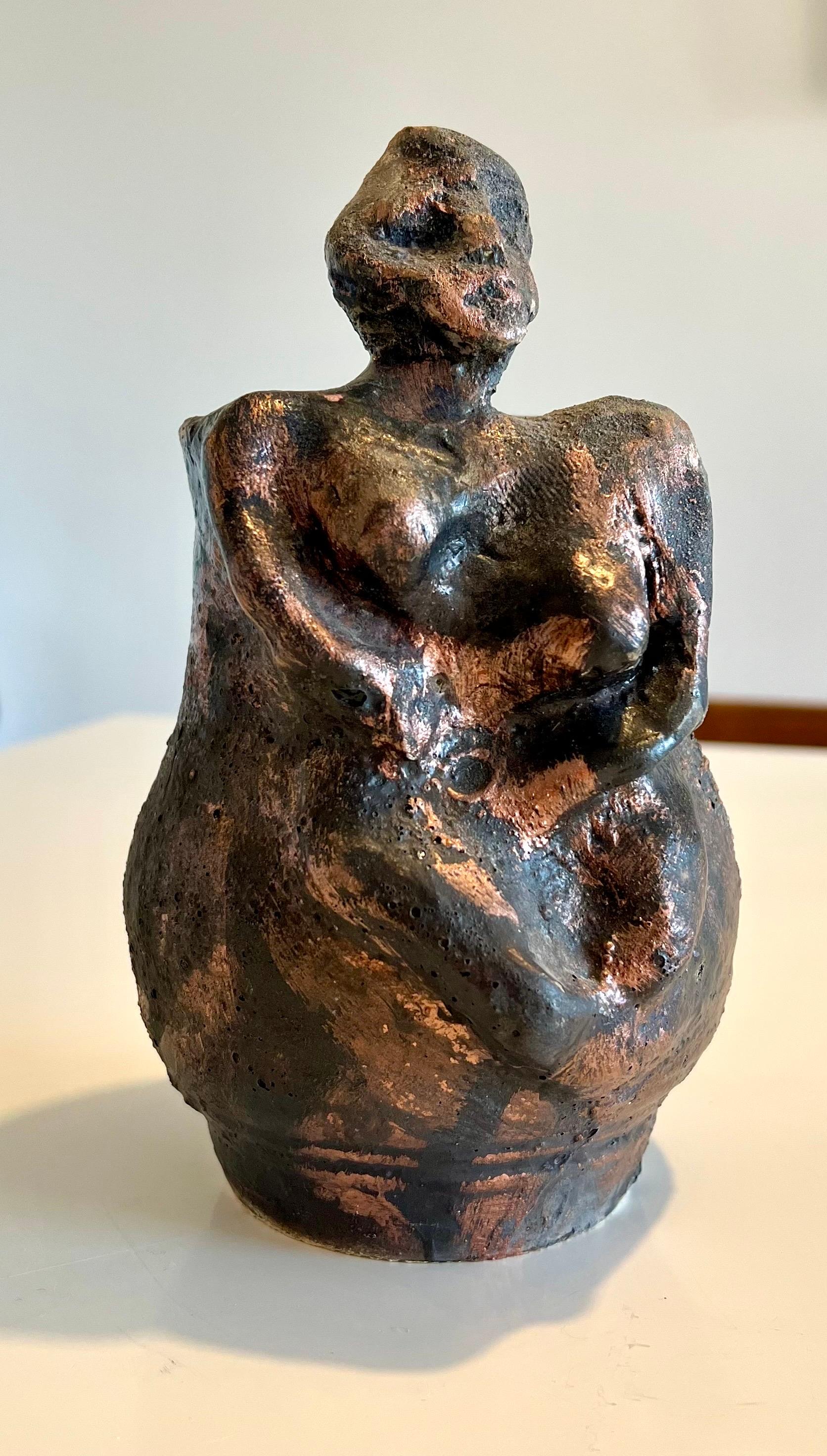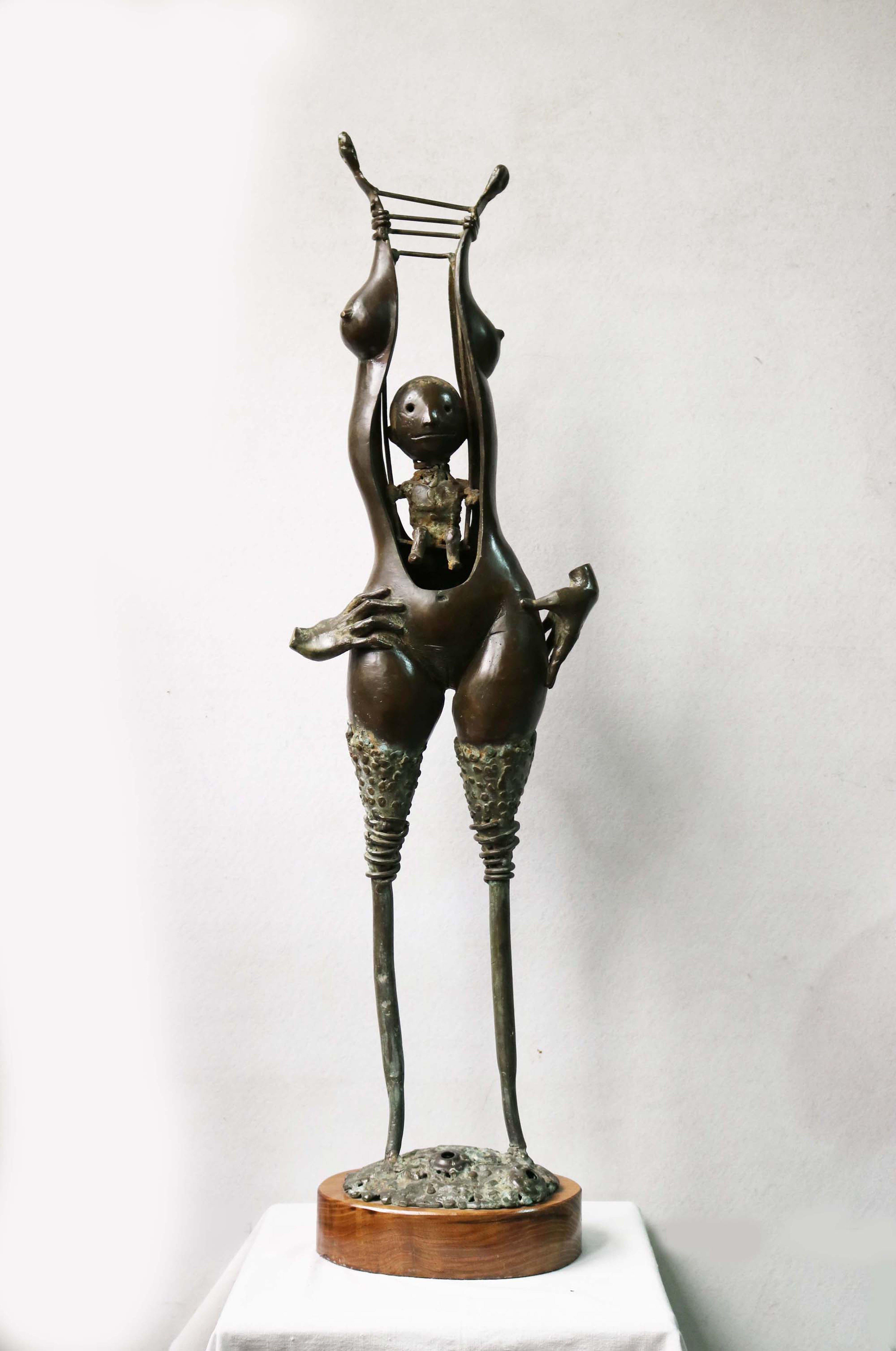Items Similar to Dame Elisabeth Frink. Bronze Maquette for Man and Eagle in Relief.Numbered 1/7.
Want more images or videos?
Request additional images or videos from the seller
1 of 20
Elisabeth FrinkDame Elisabeth Frink. Bronze Maquette for Man and Eagle in Relief.Numbered 1/7. 1967
1967
About the Item
Dame Elisabeth Frink.
English ( b.1930 - d.1993 ).
Maquette for Man and Eagle.
Bronze with gold brown patina
Signed and numbered 1/7 lower left
Size 8.7 inches x 10.2 inches ( 22cm x 26cm ).
Depth 2.8 inches ( 7cm )
Weight 7.1lb ( 3.24KG)
Available for sale; this original bronze plaque with raised relief is by Dame Elisabeth Frink and was conceived and cast in 1967.
The maquette is presented and supplied unmounted. There is the option to hang the plaque from 2 rings applied to the rear when in previous ownership.
This vintage bronze plaque / statue is in very good condition with a uniform gold brown patina overall.
The maquette is signed and numbered 1/7 lower left.
Literature:
B. Robertson, Elisabeth Frink Sculpture: Catalogue Raisonné, Salisbury, 1984, pp. 170-171, no. 158, as 'Bronze plaque (maquette for Man and Eagle Relief)'
A. Ratuszniak, Elisabeth Frink: Catalogue Raisonné of Sculpture 1947-93, Farnham, 2013, p. 106, no. FCR183, as 'Bronze plaque (maquette for Man and Eagle Relief)'.
The photographs featured here have been taken with a selection of tungsten and fluorescent light so as to provide a varying contrast so as to pick out the features and textures.
Dame Elisabeth Frink was one of Britain’s most important post-war sculptors, an accomplished draughtsman, illustrator and teacher. She was part of the post-war school of expressionist British sculptors dubbed the Geometry of Fear, and enjoyed a highly acclaimed career that was commercially successful, broke boundaries and contributed greatly to bringing wonderful sculpture to public places.
She was born on 14 November 1930 in Thurlow, the daughter of a cavalry officer, and brought up in rural Suffolk near to an active airbase. She was brought up a Catholic and educated at the Convent of the Holy Family, Exmouth.
She then studied at the Guildford School of Art from 1947-1949 under Willi Soukop and Henry Moore’s assistant, Bernard Meadows, and then at the Chelsea School in London 1949-1953. She taught at Chelsea School of Art 1951-61, St. Martin’s School of Art 1954-62 and was a visiting instructor at the Royal College of Art 1965-1967, after which she lived in France until 1973.
Frink first came to the attention of the public in 1951 at an exhibition at the Beaux Arts Gallery, London. In 1952 she represented Britain at the Venice Biennale, being described by Herbert Read as “the most vital, the most brilliant and the most promising of the whole Biennale”. The same year the Tate bought its first work by her, and she began to enjoy commercial success. Thereafter she exhibited regularly and was for 27 years associated with Waddington’s, London.
The subjects which Frink was most concerned with were man, dog and horses, with and without riders. Interestingly she seldom sculpted the female form, drawing on archetypes of masculine strength, struggle and aggression. Her work has the recurring themes of the vulnerable and the predatory, in the spirit of an authentic post-war artist. It has been said that she was more concerned with representing mankind that portraits of individuals.
The appeal of her work lies in its directness, provoking a frank statement of feeling. The anatomy is often exaggerated or incorrect; the impact growing more out of her interest in the spirit of the subject. Her animals and birds may be drawn from nature but verge on the abstract, conveying raw emotion and character rather than a realistic depiction. Her unique style is characterised by a rough treatment of the surface which embeds each piece with vitality and her personal impression. In her later work even the distinction between human and bird figures becomes blurred. Commentators have noted that the often rugged, brutal and contorted surfaces of her work reflect the destruction and terror of the six-year world-wide conflict that she witnessed as a child. Frink was an active supporter of Amnesty International.
In the 1960s and early 1970s Frink produced a notable series of falling figures and winged men. Later, living in France during the Algerian war, she began making heads, blinded by goggles which had a threatening facelessness.
Frink produced many notable public commissions, including Wild Boar for Harlow New Town, Blind Beggar and Dog for Bethnal Green, Noble Horse and Rider for Piccadilly, London, a lectern for Coventry Cathedral, Shepherd for Paternoster Square beside St. Paul’s Cathedral and a Walking Madonna for Salisbury Cathedral. In the early 1980s she produced a set of three larger than life figures The Dorset Martyrs which stand on the edge of the old walled town of Dorchester on the site of the old gallows, as a memorial to those who had been executed there ‘for conscience sake’.
Frink’s Canterbury Tales was a collection of 19 etchings drawn directly on to copper plates and etched by her. The ‘book’ was issued in three limited editions. Her illustrations have been praised as “amongst the most successful illustrations of the century, encompassing the mood of the text in concise delineations and disarmingly ribald humour”. She illustrated other books with coloured lithographs or drawings.
Frink was on the Board of Trustees, British Museum from 1976, and was a member of the Royal Fine Art Commission 1976-81. CBR (1969), DBE ((1982), Associate of the Royal Academy (1971), Royal Academy (1977). She was made a Companion of Honour in 1992. She died on 18 April 1993, but not before completing her last commission, a monumental but unusual figure of Christ for the front of the Anglican Cathedral in Liverpool, unveiled a week before her death.
For several decades Frink exhibited widely in the UK and abroad. In her later years she lived and worked in Dorset where her garden became an arena for her work.
In 1985 she had a retrospective at the Royal Academy. She died on 18 April 1993, but not before completing her last commission, a monumental but unusual figure of Christ for the front of the Anglican Cathedral in Liverpool, unveiled a week before her death. There was a memorial show at Yorkshire Sculpture Park, Bretton Hall in 1994.
Today Frink is venerated as one of the great twentieth century British sculptors. Her unique work is represented in the Tate Gallery and major public and private collections world-wide.
© Big Sky Fine Art
This bronze maquette with gold brown patina was produced by Frink for the work Man and Eagle Relief. It is signed and numbered 1 of 7. Conceived and cast in 1967. It depicts the heavy standing figure of a man in the top left corner, bearing down towards a second naked figure, who is seated and looking away. In the bottom right hand corner there is the head of a huge eagle, its outstretched wing reaching over the head of the seated figure as if in a protective gesture.
- Creator:Elisabeth Frink (1930-1993, British)
- Creation Year:1967
- Dimensions:Height: 8.67 in (22 cm)Width: 10.24 in (26 cm)Depth: 2.76 in (7 cm)
- Medium:
- Movement & Style:
- Period:
- Condition:This vintage bronze relief sculpture is in very good condition with a uniform gold brown patina overall.
- Gallery Location:Sutton Poyntz, GB
- Reference Number:1stDibs: LU489314075212
About the Seller
5.0
Gold Seller
These expertly vetted sellers are highly rated and consistently exceed customer expectations.
Established in 2010
1stDibs seller since 2016
110 sales on 1stDibs
Typical response time: 1 hour
- ShippingRetrieving quote...Ships From: Sutton Poyntz, United Kingdom
- Return PolicyA return for this item may be initiated within 14 days of delivery.
More From This SellerView All
- Llangorse Lake, Brecon Beacons, Wales, circa 1964. Welsh Landscape. Abstract.By Roger CecilLocated in Sutton Poyntz, DorsetRoger Cecil. Welsh ( b.1942 - d.2015 ). Llangorse, Brecon Beacons Watercolor and pastel on paper. Signed. Image size 19.5 inches x 29.5 inches ( 49.5cm x 75cm ). Frame size 24.6 inches x 34.6 inches ( 62.5cm x 88cm ). Available for sale; this original painting is by the Welsh artist Roger Cecil and dates from around 1964. The watercolor and pastel work is presented and supplied in a sympathetic contemporary frame (our stock frame, which is shown in these photographs), mounted using conservation materials and behind glass. The original backboard has been reused but the artwork has been isolated from it using conservation barrier materials. This vintage artwork is in good condition, commensurate with its age. Previous cockling (rippling) of the paper has been eliminated by stretching and the use of a new mounting. Previous foxing and age marks have been mechanically removed and the coarse fiber of the paper has been made good in these areas. The painting is now ready to hang and display. The watercolor is signed lower left. Provenance: Previously with the Howard Roberts Gallery, Imperial Buildings, 69/74 St Mary Street, Cardiff. Roger Cecil was a reclusive painter, draughtsman and teacher who was born in Abertillery, Monmouthshire in 1942. He lived and worked in Wales for the last four decades of his life, much of it in the house where he was born and brought up. Cecil produced abstract work rich in imagery, poetry and color, which were drawn from his environment, the industrial valley towns and mountains. Prolific and obsessive, he was always a solitary artist, with no affiliations to any group or artistic movement. He worked for more than forty years, with an ever evolving and prolific creative output. His pictures capture the geology and the history of the places he knew so intimately, and the impact of man of that environment. Cecil studied Fine Art at Newport College of Art from 1959 to 1963, where his teachers included John Wright and Thomas Rathmell; in 1963 he gained the College’s highest award in the national diploma in design and a place at the Royal College London. In 1964 he won the David Murray Landscape Award from the RA. He took up his place at the Royal College of Art, but after just a few weeks he was unsatisfied and instead took up manual work in opencast mines and building sites. Cecil later spent some time teaching at Ebbw Vale. From 1995 to 1998 he did his MA, which he gained with distinction in communication design at St. Martin’s College of Art. The BBC made a television documentary on Cecil's work called The Gentle Rebel. For a long time Cecil did not exhibit, through choice, and it was friends who helped to promote him. He then had a series of exhibitions at Business Art Galleries from 1987, and in 1995 the Hill Court Gallery, Abergavenny, held a retrospective of his work. In 1998 Gordon Hepworth and Y Tabernacl both showed Cecil's pictures. Cecil’s works were also shown at the Oriel Myrddin Gallery in 2006 and 20011. The small book which takes the name of the earlier exhibition ”Cariad”; has an introduction by gallery manager Meg Anthony which states; “The magic of Roger Cecil’s work is in part down to the man, for he is enigmatic and surprising, diffident and proud. He has deliberately avoided the art establishment, remaining shy of its protocol and systems of exposure and recognition. He has consciously created the space to pursue his art, away from the pressures of publicity and celebrity...... paint is Roger’s passion.” Cecil’s methods were complex; he worked with a mixture of materials, including oil pastels, sandpaper, primer and plaster. He built up layers and then he rubbed and scratched them away. His work is textured and nuanced, and the color reverberates as if it has a life of its own. The paintings are abstract, but there are echoes of monumental shapes and undulations of the female form, the Valleys - the dark hills embracing the bowls of space and the rich, gritty textures of the industrial and post-industrial landscape, highlighted by intricate, personal marks. Sarah Bradford states: “Scale is an important feature of Roger Cecil’s work; he constantly shifts from near and the far off. He also moves his viewpoint from looking at, to looking down on to. This looking down, as though a bird, onto the world of the painting, comes from exploration of his surroundings and from the ordinance survey maps he takes with him when he walks. He has often said how he is inspired by the language of symbols and lines that are used in maps to delineate the landscape. It is easy to see the connection when looking at the networks of invented footpaths, waterways, and other pinpoint features that can be found in his work.” … Mary Lloyd...Category
Mid-20th Century Abstract Expressionist Landscape Drawings and Watercolors
MaterialsPaper, Pastel, Watercolor
- Enigma. Original Oil Painting. Eccentric & Bohemian. Modern British. Welsh.By Meryl WattsLocated in Sutton Poyntz, DorsetMeryl Watts. English ( b.1910 – d.1992 ) Enigma. Oil on Board. Signed. Image size 22.4 inches x 19.3 inches ( 57cm x 49cm ). Frame size 26.4 inches x 22.8 inches ( 67cm x 58cm ). Av...Category
Mid-20th Century Abstract Abstract Paintings
MaterialsOil, Board
- Flock of Sheep. Large Pastel.Modern British.West Wales.Welsh. Animal & Farming.Located in Sutton Poyntz, DorsetSusan Pomery Wilks. English ( 20th Century ). Flock of Sheep. Pastel & Charcoal on Paper. Signed. Image size 13.6 inches x 23 inches ( 34.5cm x 58.5cm ). Frame size 21.1 inches x 30...Category
Late 20th Century Abstract Animal Drawings and Watercolors
MaterialsPaper, Charcoal, Pastel
- Scaling Dam, North Yorkshire. Abstract English Landscape. Original Oil Painting.By Peter M. HicksLocated in Sutton Poyntz, DorsetPeter M. Hicks. English ( b.1937 ). Scaling Dam, North Yorkshire. Oil on Canvas. Signed. Image size 17.1 inches x 44.9 inches ( 43.5cm x 114cm ). Available for sale; this original ...Category
Late 20th Century Abstract Landscape Paintings
MaterialsOil
- The Climbers, 1970. Geometric Abstract Parallel Projection.Ruskin School Oxford.Located in Sutton Poyntz, DorsetJohn Coverdale Newberry. English ( b.1934 ). The Climbers, 1970. Oil on Canvas Board. Signed. Image size 9.8 inches x 8.1 inches ( 25cm x 20.5cm ). Frame size 14.2 inches x 12.2 inc...Category
Mid-20th Century Abstract Geometric Abstract Paintings
MaterialsOil, Board
- Moonlight Embrace. Colorwash & Ink.En Grisaille.Male & Female Nude.Picasso like.Located in Sutton Poyntz, DorsetKeith Bayliss. Welsh ( b.1954 ). Moonlight Embrace. Color Wash and Ink. Signed. Image size 10.4 inches x 14.4 inches ( 26.5cm x 36.5cm ). Frame size 16.7 inches x 20.1 inches ( 42.5...Category
Late 20th Century Constructivist Nude Drawings and Watercolors
MaterialsPaper, Ink, Watercolor
You May Also Like
- Bronze sculpture "Soulmates II"By ShrayLocated in Palm Beach, FLBronze sculpture by a renowned American artist - Shray Shray continues her exploration of her bronze works using a black patina that recasts her sculpture's impact on negative spac...Category
2010s Abstract Expressionist Figurative Sculptures
MaterialsBronze
- Balance StruckBy ShrayLocated in Palm Beach, FLBronze sculptor, Shray, is one of the few working artists today who employs the rare Subtractionist technique. Like Michaelangelo, who released the human form in stone, Shray unveils...Category
2010s Abstract Expressionist Figurative Sculptures
MaterialsBronze
- "Victim of War (WWII)" Signed, Stainless Steel SculptureLocated in Clinton Township, MIThis dramatic stainless steel sculpture titled "Victim of War" by Marian Owczarski depicts a falling figure reaching towards the sky. The figure is suspended by a single leg which Ow...Category
Late 20th Century Abstract Expressionist Figurative Sculptures
MaterialsStainless Steel
- Mid-Century Nude Male Acephale Sang de Boeuf Ceramic Sculpture with Marble Base.By Franta (Frantisek Merte)Located in Cotignac, FRFrench Mid 20th Century ceramic figure of a man in Sang de Boeuf, oxblood red, glaze presented on a metal 'tige' and marble base. The sculpture is not signed but was purchased from ...Category
Mid-20th Century Abstract Expressionist Nude Sculptures
MaterialsMarble
- Brutalist Ceramic Sculpture Vase Bronze Lustre FInish California ExpressionistBy Jenik CookLocated in Surfside, FLJenik Cook Handmade ceramic vase or pot sculpture Hand signed by the artist. Fired clay with a luster bronze painted finish Jenik Esterm Simonian Cook is a painter and ceramicist ...Category
20th Century Abstract Expressionist Figurative Sculptures
MaterialsCeramic, Luster, Paint
- 'Early Childhood, ' by Arman Hambardzumyan, Bronze SculptureBy Arman HambardzumyanLocated in Oklahoma City, OKThis 35.43" x 9.84" bronze sculpture by Armenian artist, Arman Hambardzumyan, features a faceless figural form with long legs and a short torso. Th...Category
2010s Abstract Figurative Sculptures
MaterialsBronze





